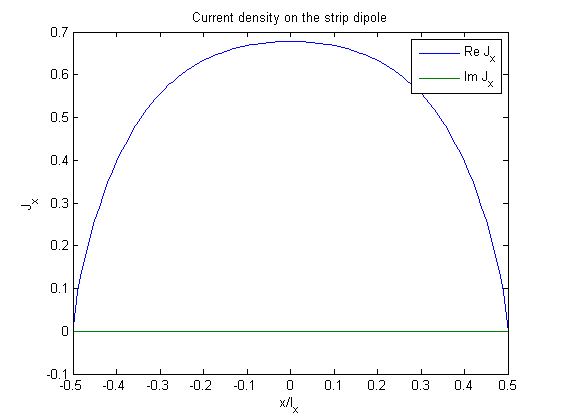clear all
k1=0.5*2*pi; k2=k1; kN=1; lx=1; ly=0.02; Nx=100; Ny=1;
lib = '..\data';
Calc_RX_matrices_rec(k1,k2,kN,lx,ly,Nx,Ny,lib);
load(strcat(lib,'/RowRX_rec_x=1_y=0p02_Nx=100_Ny=1_k=3p1416'));
[Xe,p] = RX_rec_sym2full(Xe11,Xe12,Xe22,bas.BxNN,bas.ByNN,meshp.txN,meshp.tyN,2);
[Xm,p] = RX_rec_sym2full(Xm11,Xm12,Xm22,bas.BxNN,bas.ByNN,meshp.txN,meshp.tyN,2);
[Rr,p] = RX_rec_sym2full(Rr11,Rr12,Rr22,bas.BxNN,bas.ByNN,meshp.txN,meshp.tyN,2);
if 1
evh = [1 0 0];
rvh = [0 0 1];
F = farfieldmatrix(kl,bas,meshp,evh,rvh);
else
sphn = 6;
F = sphmodematrix(kl,bas,meshp,sphn);
end
cvx_begin
variable I(N) complex;
variable w;
minimize w
subject to
quad_form(I,Xe) <= w;
quad_form(I,Xm) <= w;
F*I == -1i;
cvx_end
GoQ = 4*pi/(w*eta0)
figure(1); clf
x = linspace(-lx/2,lx/2,N+2);
plot(x,real([0; I/dy; 0]),x,imag([0; I/dy; 0]))
title('Current density on the strip dipole')
xlabel('x/l_x')
ylabel('J_x')
legend('Re J_x','Im J_x')
P = abs(F*I)*abs(F*I)/2/eta0;
Pr = real(I'*Rr*I)/2;
D = 4*pi*P/Pr
We = real(I'*Xe*I)/4/kl;
Wm = real(I'*Xm*I)/4/kl;
W = max(We,Wm);
Q = 2*kl*W/Pr
Qe = 2*kl*We/Pr;
Qm = 2*kl*Wm/Pr;
Nx =
100
Ny =
1
kn/kN=1.000, t=0:0:1, rt=0:0:0
Calling SDPT3 4.0: 405 variables, 202 equality constraints
For improved efficiency, SDPT3 is solving the dual problem.
------------------------------------------------------------
num. of constraints = 202
dim. of socp var = 400, num. of socp blk = 2
dim. of linear var = 2
dim. of free var = 3 *** convert ublk to lblk
*******************************************************************
SDPT3: Infeasible path-following algorithms
*******************************************************************
version predcorr gam expon scale_data
NT 1 0.000 1 0
it pstep dstep pinfeas dinfeas gap prim-obj dual-obj cputime
-------------------------------------------------------------------
0|0.000|0.000|8.3e+03|8.5e+02|4.4e+04| 4.032922e+01 0.000000e+00| 0:0:00| chol 1 1
1|0.972|0.965|2.4e+02|2.9e+01|2.9e+03| 2.425279e+01 -1.675440e+03| 0:0:00| chol 1 1
2|1.000|0.350|8.2e-06|1.9e+01|1.2e+03| 6.053100e+00 -1.136137e+03| 0:0:00| chol 1 1
3|1.000|0.944|7.1e-06|1.1e+00|7.0e+01| 1.621333e+00 -6.327848e+01| 0:0:00| chol 1 1
4|0.980|0.933|5.4e-07|7.2e-02|4.7e+00| 1.124395e+00 -3.219186e+00| 0:0:00| chol 1 1
5|0.988|0.983|1.8e-07|1.2e-03|7.9e-02| 1.112303e+00 1.040646e+00| 0:0:00| chol 1 1
6|0.954|0.049|1.5e-06|1.2e-03|7.6e-02| 1.111034e+00 1.044105e+00| 0:0:00| chol 1 1
7|1.000|0.453|4.6e-08|6.4e-04|4.2e-02| 1.110706e+00 1.074286e+00| 0:0:00| chol 1 1
8|0.808|0.327|4.0e-08|4.3e-04|2.8e-02| 1.109769e+00 1.086000e+00| 0:0:00| chol 1 1
9|1.000|0.298|2.3e-08|3.0e-04|2.0e-02| 1.109392e+00 1.093013e+00| 0:0:00| chol 1 1
10|0.996|0.650|3.6e-09|1.1e-04|7.0e-03| 1.108967e+00 1.103484e+00| 0:0:00| chol 1 1
11|0.635|0.489|4.6e-09|5.4e-05|3.6e-03| 1.108771e+00 1.106069e+00| 0:0:00| chol 1 1
12|0.461|0.678|5.6e-09|1.8e-05|1.2e-03| 1.108687e+00 1.107807e+00| 0:0:00| chol 1 1
13|0.577|0.742|3.1e-09|4.6e-06|3.2e-04| 1.108649e+00 1.108417e+00| 0:0:00| chol 1 1
14|0.876|0.800|7.2e-10|9.4e-07|6.4e-05| 1.108637e+00 1.108591e+00| 0:0:00| chol 1 1
15|0.985|0.949|1.1e-10|7.1e-08|3.4e-06| 1.108636e+00 1.108634e+00| 0:0:00| chol 1 1
16|0.995|0.963|9.5e-12|3.3e-09|1.4e-07| 1.108636e+00 1.108636e+00| 0:0:00| chol 1 1
17|1.000|0.933|3.9e-11|1.7e-10|1.0e-08| 1.108636e+00 1.108636e+00| 0:0:00|
stop: max(relative gap, infeasibilities) < 1.49e-08
-------------------------------------------------------------------
number of iterations = 17
primal objective value = 1.10863592e+00
dual objective value = 1.10863592e+00
gap := trace(XZ) = 1.01e-08
relative gap = 3.14e-09
actual relative gap = 1.80e-09
rel. primal infeas = 3.88e-11
rel. dual infeas = 1.66e-10
norm(X), norm(y), norm(Z) = 7.7e+02, 8.5e-01, 1.0e+00
norm(A), norm(b), norm(C) = 3.0e+03, 3.6e+00, 3.5e+00
Total CPU time (secs) = 0.48
CPU time per iteration = 0.03
termination code = 0
DIMACS: 4.1e-11 0.0e+00 2.7e-10 0.0e+00 1.8e-09 3.1e-09
-------------------------------------------------------------------
------------------------------------------------------------
Status: Solved
Optimal value (cvx_optval): +0.0958593
GoQ =
0.3480
D =
1.6811
Q =
4.8313

